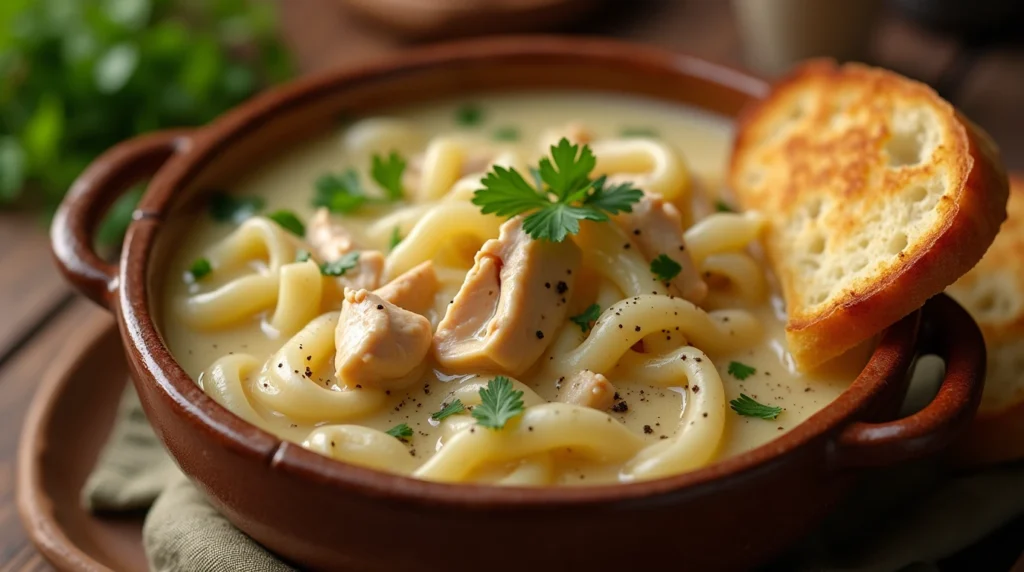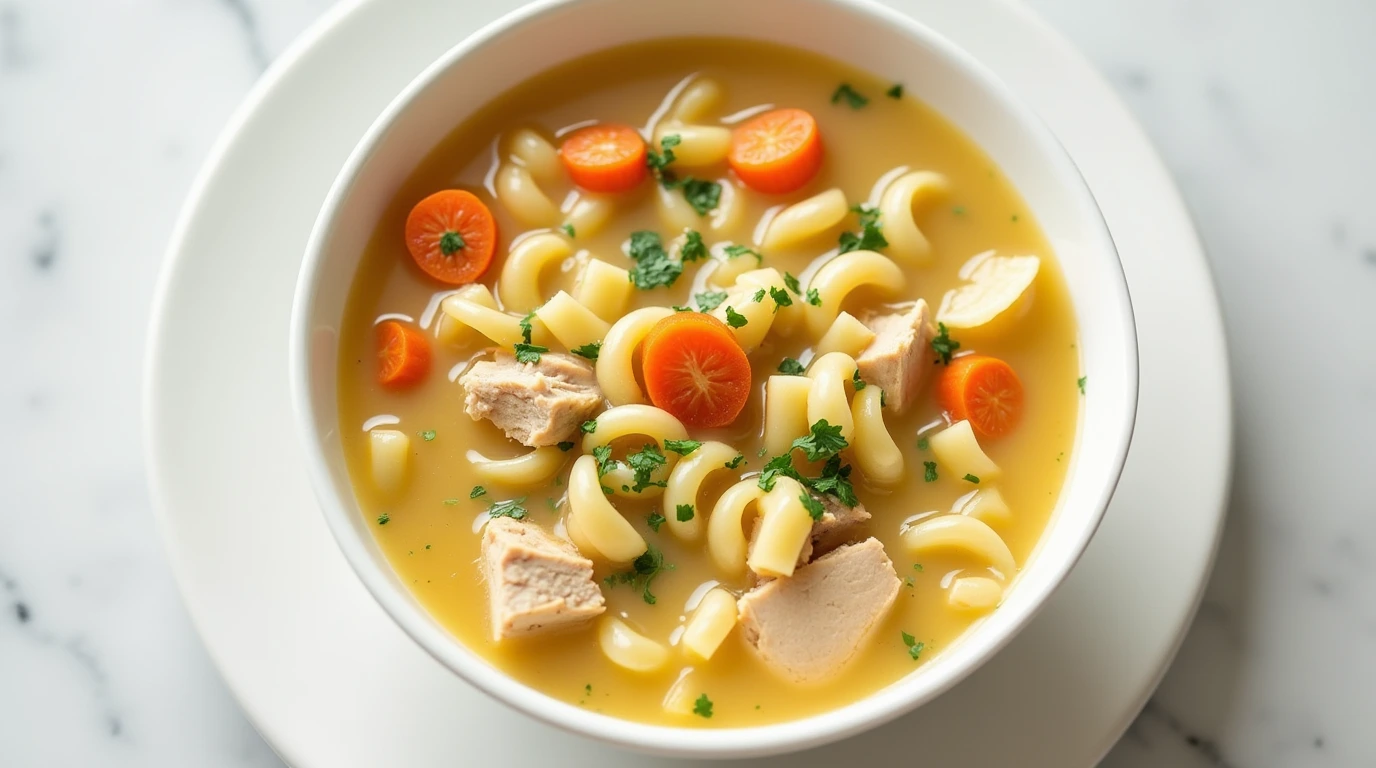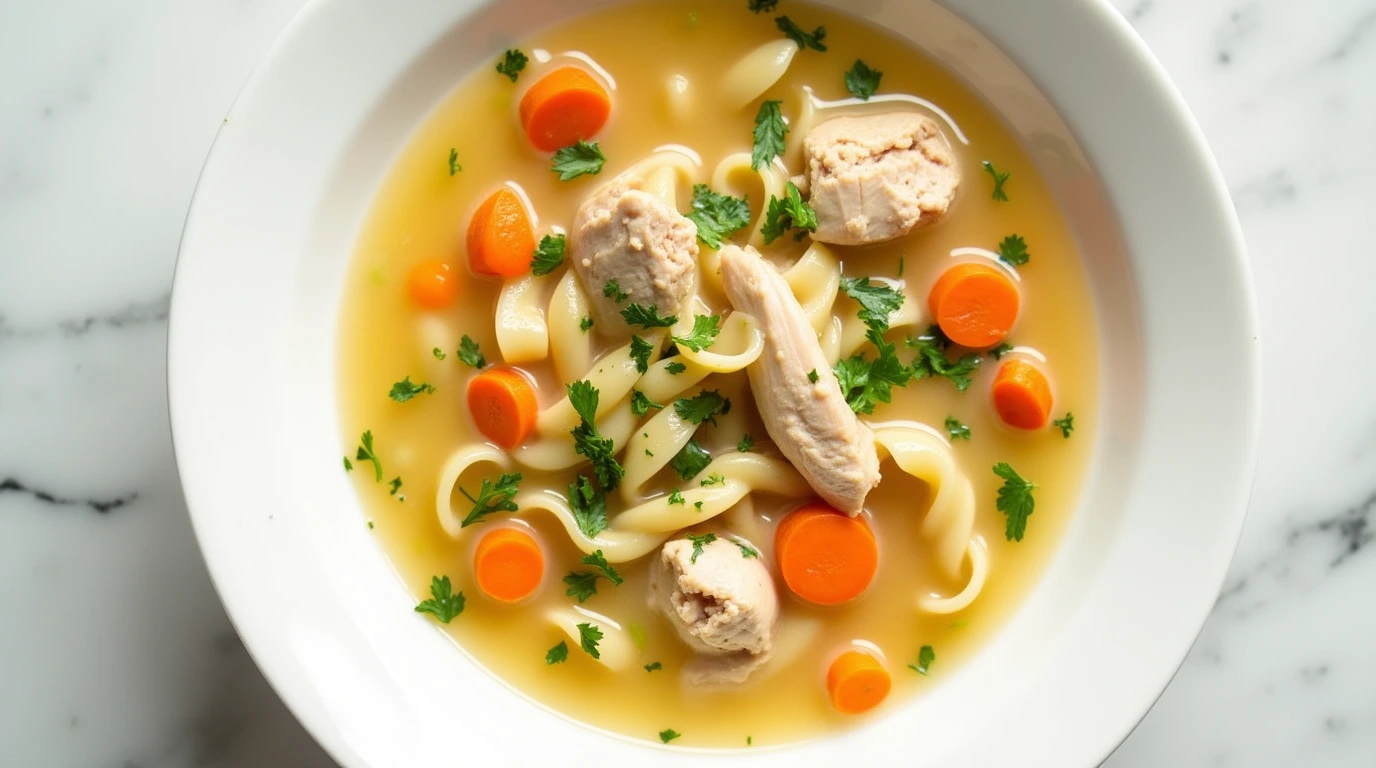Creamy chicken noodle soup is the ultimate comfort food, blending tender chicken, soft noodles, and fresh vegetables in a rich, velvety broth. The secret to achieving a perfectly creamy texture lies in understanding the right ingredients and techniques.
In this guide, we’ll answer questions like “What makes soup more creamy?”, “How can I thicken my chicken noodle soup?”, and more. Plus, explore our detailed creamy chicken noodle soup recipe for step-by-step instructions to perfect your bowl.
What Makes Soup More Creamy?
The Role of Dairy in Creating Creaminess
Adding dairy products is one of the easiest ways to make soup more creamy. Ingredients like heavy cream, half-and-half, and cream cheese enrich the broth, giving it a silky texture. Butter and milk are also common choices to add smoothness without overpowering the soup’s flavor.
Non-Dairy Alternatives for Creamy Soup
If you’re looking for dairy-free options, these alternatives can achieve similar results:
- Coconut Milk: Adds creaminess with a subtle sweetness.
- Cashew Cream: Soaked and blended cashews create a thick, creamy consistency.
- Almond Milk: A lighter option for those avoiding heavy fats.
Thickening Agents to Enhance Texture
To thicken creamy soups without altering the flavor too much:
- Flour or Cornstarch: Create a roux with butter and flour or a cornstarch slurry to thicken the broth.
- Potatoes: Blend boiled potatoes into the soup for natural thickening.
- Blended Soup Base: Puree a portion of the soup and stir it back in for a creamier texture.
How Can I Thicken My Chicken Noodle Soup?
To thicken chicken noodle soup, consider these techniques:
- Use a Roux: Combine equal parts butter and flour, then cook until golden. Stir it into the soup to thicken the broth.
- Add Cream or Milk: Stir in heavy cream, half-and-half, or whole milk toward the end of cooking for a creamy finish.
- Incorporate Pureed Vegetables: Blend some of the cooked carrots, celery, or potatoes for added body.
- Add Cheese: A handful of grated Parmesan or cheddar can both thicken and enrich the flavor.
What is the Difference Between Condensed Cream of Chicken Soup and Regular Cream of Chicken Soup?
- Condensed Cream of Chicken Soup:
- This is a concentrated version of cream of chicken soup, often sold canned. It’s meant to be diluted with water or milk during preparation.
- It’s thicker and more intense in flavor, commonly used in casseroles or as a base for recipes.
- Regular Cream of Chicken Soup:
- This is a ready-to-eat version with a lighter consistency, typically served as a standalone soup.
- It’s less concentrated and designed for direct consumption without additional preparation.
Is Chicken Stock or Broth Better for Chicken Noodle Soup?
- Chicken Stock:
- Made by simmering chicken bones, it has a richer and more robust flavor, making it ideal for hearty soups like chicken noodle soup.
- Adds depth to the dish, especially when paired with creamy ingredients.
- Chicken Broth:
- Simmered with chicken meat, it has a lighter flavor compared to stock.
- Best for a milder soup or when the focus is on creaminess rather than bold flavors.
Conclusion: Both work well, but stock is preferred for a richer, more complex soup, while broth is great for a lighter, delicate base.
For more detailed steps and tips on making creamy chicken noodle soup, visit our ultimate comfort food recipe.
Tips for Perfectly Creamy Soup Every Time
1. Preventing Curdling
To ensure a smooth and creamy soup, avoid curdling by following these tips:
- Warm the Dairy: Gradually warm milk or cream before adding it to the soup to prevent shock from temperature changes.
- Add Dairy Last: Stir in cream or milk at the end of cooking, keeping the heat low.
- Stir Constantly: Prevent the dairy from sticking to the pot by stirring frequently.
2. Balancing Flavors
Achieving the perfect balance of flavors enhances the creaminess of the soup:
- Salt and Pepper: Season gradually and taste as you go.
- Acidity: Add a splash of lemon juice or vinegar to brighten the flavors without overpowering the creamy texture.
- Fresh Herbs: Incorporate parsley, dill, or thyme for a fresh, aromatic touch.
3. Storing and Reheating Creamy Soup
Creamy soups can lose their texture when reheated improperly. Follow these tips:
- Storage: Store in an airtight container in the refrigerator for up to 3 days.
- Reheating: Heat gently on the stovetop over low heat, stirring often. Avoid boiling, which can cause the cream to separate.
- Freezing: Freeze without cream and noodles for better results. Add these ingredients fresh when reheating.
Variations of Creamy Chicken Noodle Soup
1. Gluten-Free Creamy Chicken Noodle Soup
Use gluten-free pasta and substitute the roux with cornstarch or gluten-free flour to create a thick, creamy base.
2. Spicy Creamy Chicken Noodle Soup
Add diced jalapeños or a dash of cayenne pepper for heat. A splash of hot sauce in the creamy broth can also elevate the flavor.
3. Dairy-Free Creamy Chicken Noodle Soup
Replace cream with coconut milk or cashew cream. Use olive oil instead of butter for a completely dairy-free option.
FAQs About Making Creamy Soups
Here are answers to common questions about creating the perfect creamy chicken noodle soup.
1. What Are the Best Dairy-Free Options for Creamy Soup?
If you’re avoiding dairy, try these substitutes:
- Coconut Milk: Adds a rich texture and subtle sweetness.
- Cashew Cream: Soak and blend cashews for a creamy consistency.
- Almond Milk: A lighter option for those who prefer mild flavors.
- Oat Milk: Thick and neutral, great for soups requiring a creamy base.
2. Can I Use Alternative Flours as a Thickener?
Yes, alternative flours can be used:
- Gluten-Free Flour: Works the same as regular flour for making a roux.
- Cornstarch: Mix with water to create a slurry for a glossy finish.
- Arrowroot Powder: A natural thickener with a neutral taste, perfect for soups.
3. How Do I Keep Creamy Soup from Separating?
To prevent separation:
- Add Cream Last: Incorporate cream or milk after reducing the heat to low.
- Stir Often: Maintain a consistent texture by stirring while reheating.
- Avoid Boiling: High heat can cause dairy to curdle and separate.
For more detailed steps, tips, and variations on this dish, check out our ultimate creamy chicken noodle soup recipe.
Conclusion: Master the Art of Creamy Chicken Noodle Soup
Making creamy chicken noodle soup is as much about technique as it is about ingredients. Whether you’re using traditional dairy or experimenting with plant-based options, the goal is to create a rich and velvety texture that complements the hearty flavors of chicken, noodles, and vegetables. With the tips and techniques shared here, you’ll achieve soup perfection every time.





